To ease the planning process and to make sure children get the most out of the experience, Moon Guides authors have compiled their top kid-friendly activities at National Parks.
The crystal clear water of Lake McDonald lets visitors see the colorful smooth ancient rocks that formed the mountains. It also lures kids for swimming in the shallows on sunny days, and families for paddling from Apgar or Lake McDonald Lodge.
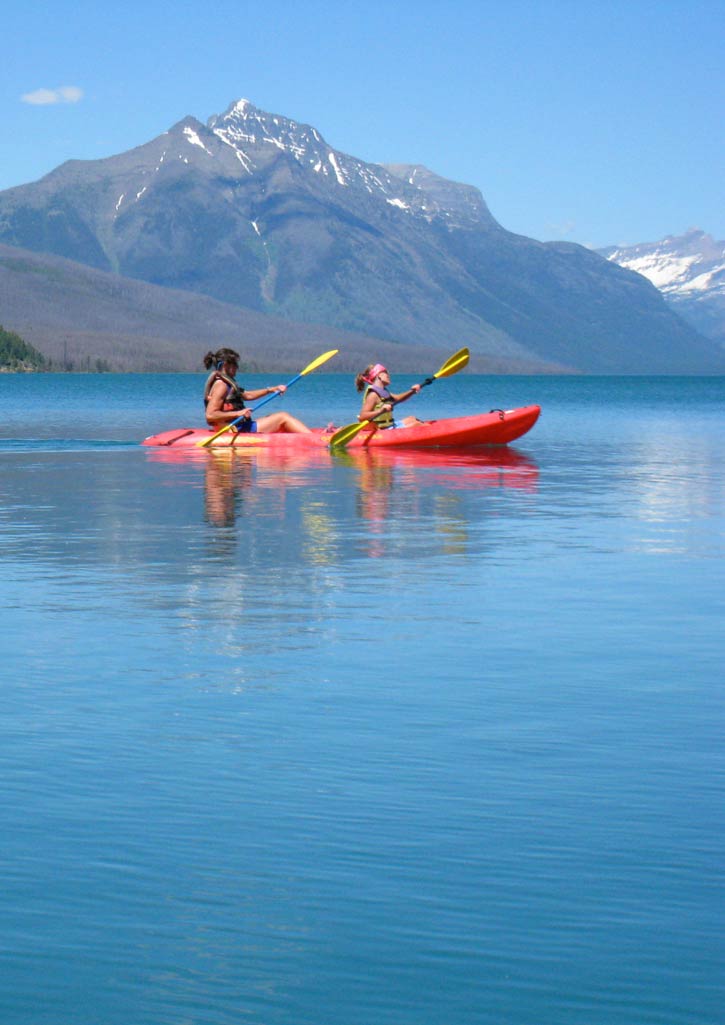
Paddling in Lake McDonald. Photo © Becky Lomax.
Families can bicycle the 1.5-mile Apgar Bike Trail to enjoy the pine forest, spot deer, hear varied thrush whistle, and see the Middle Fork of the Flathead River.
At Logan Pass, walk an interpretive loop made for kids with hand-cranked vocal descriptions to accompany panels on alpine wildlife, and then hike 1.5 miles to Hidden Lake Overlook to see mountain goats and bighorn sheep.
—Becky Lomax, author of Moon Glacier National Park
Visit the Junior Ranger Cabin at Madison Junction to learn about bison and other wildlife in naturalist presentations for kids. Kids can check off one of the required activities there to become a Junior Ranger.
Kids love visiting Mud Volcano, where bubbling, gurgling mud pots look like storybook witch’s brews. Dragon’s Mouth belches noisily, and Black Dragon’s Cauldron bubbles a dark soup with the stench of hydrogen sulfide. They’ll learn about volcanic activity on the interpretive boardwalk.
Yellowstone’s rivers are prime places to catch wild trout. Teach kids to fish on the Madison River while bison hang in the area.
—Becky Lomax, author of Moon Glacier National Park
Kids of all ages can hike the 2-mile Colter Bay Lakeshore Trail around Colter Bay Peninsula. The trail connects with several beaches for play stops and best of all, ends at the picnic and swimming area on Jackson Lake.
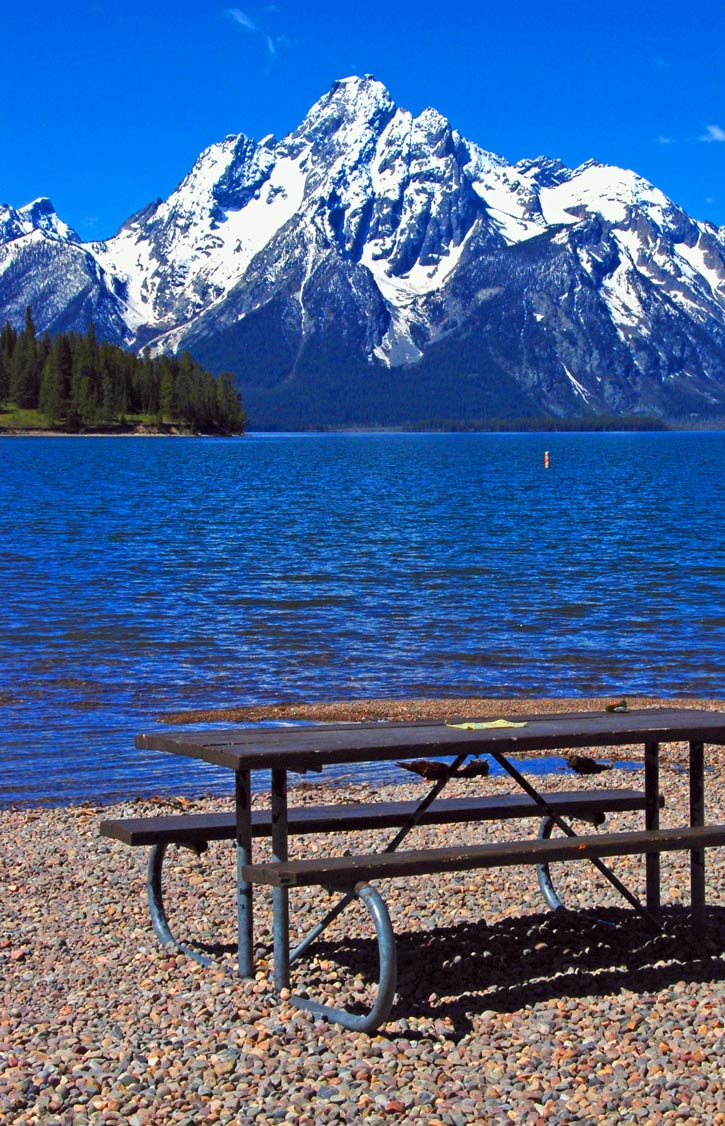
Picnic at Colter Bay in Grand Teton National Park. Photo © Becky Lomax.
The 16-mile Multi-use Pathway offers a safe place for families with kids to bicycle since it is off the roadway. Rent bikes at Dornan’s in Moose, Jackson, or Teton Village to bike a portion of the trail.
—Becky Lomax, author of Moon Glacier National Park
Ocean and lakes, granite peaks and rocky headlands, sandy beaches and tidal pools, carriage roads and hiking trails: Acadia National Park on Mount Desert Island has it all. Acadia is a bona fide treasure chest for families, a collection of unique and authentic experiences that blend fun with education and adventure with awareness.
When planning your family vacation, register either online or by phone forAcadia Quest, a free, experiential, family-oriented scavenger hunt that immerses participants in the park. All kids who complete the hunt earn a Quest Patch; each team (family) that finishes earns a park pass for the following season and is entered into a drawing for a grand prize. You might also consider enrolling in the College of the Atlantic’s Family Nature Camp, a weeklong program that includes housing and meals as well as guided nature programs in the park.
Once on the island, stop at the visitor center to sign kids up for the Junior Ranger Program, and then peruse the park calendar to select ranger-led activities that met your family’s interests and abilities and help fulfill the requirements for earning the Junior Ranger patch.
The following hiking trails are easy and family-friendly: Ocean Trail, Jordan Pond Nature Tail, Ship Harbor Nature Trail, and Wonderland Trail. Pedal the magical, car-free carriage roads that web the park’s heartland, and pass over and under 17 unique and historical stone bridges. Perhaps even pony-up for a horse-drawn carriage ride up Day Mountain.
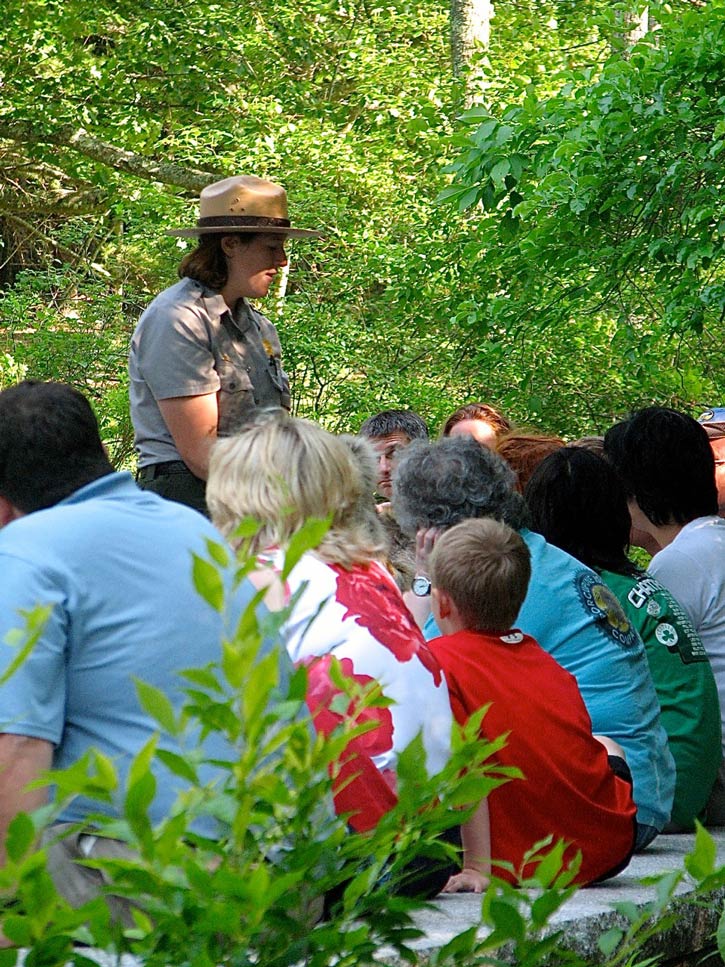
A ranger-led nature program at Acadia National Park. Photo © Hilary Nangle.
Join a ranger-narrated, kid-pleasing adventure with Diver Ed’s Dive-In Theater Boat Cruise aboard the Starfish Enterprise. Diver Ed goes overboard with a video camera and a bag of touchable specimens, giving kids a chance to pet some slimy creatures, which return to the depths after show-and-tell.
Visit the George B. Dorr Natural History Museum, which has a “please-touch” philosophy allowing kids to reach into a tidal tank and to feel fur, animal bones, and even whale baleen. Also, check out Islesford (a.k.a. Little Cranberry Island) home to the park-owned Islesford Historical Museum.
Some folks skip Sieur du Monts Springs, off the Park Loop Road, but this oasis has a number of fun finds. It’s home to the ranger-staffed Nature Center, with hands-on exhibits and programs; the original Abbe Museum, highlighting Maine’s Native American history; and the Wild Gardens of Acadia, a one-acre microcosm of Mount Desert Island’s natural habitats.
—Hilary Nangle, author of Moon Acadia National Park
From its dazzling star-studded night skies to the geological story told within its depths, Grand Canyon National Park is a treasure trove of discoveries for budding young scientists. Families in search of learning experiences (like the weeklong Star Party each June) can start with the park’s event calendar, or sign up for an outing with the Grand Canyon Field Institute. But no matter when or how you visit, here are three sure-fire ways to help your kids connect with the canyon.
Kids (and adults) are fascinated by Grand Canyon’s geological story, a two-billion-year-old tale that unfolds one rock layer at a time. To see and touch samples from each of these colorful pages in history, take a stroll along the 1.2-mile Trail of Time, an easy paved trail that leads from Grand Canyon Village to the Yavapai Geology Museum. The Trail of Time makes a good introduction to the museum’s afternoon ranger programs and geology-focused displays. Bonus: This rim-side route has plenty of perches for snapping photos of central canyon features like Zoroaster Temple and Plateau Point, and the nearby ponderosa pines offer shady relief for wildflowers, birds, mule deer—and humans.
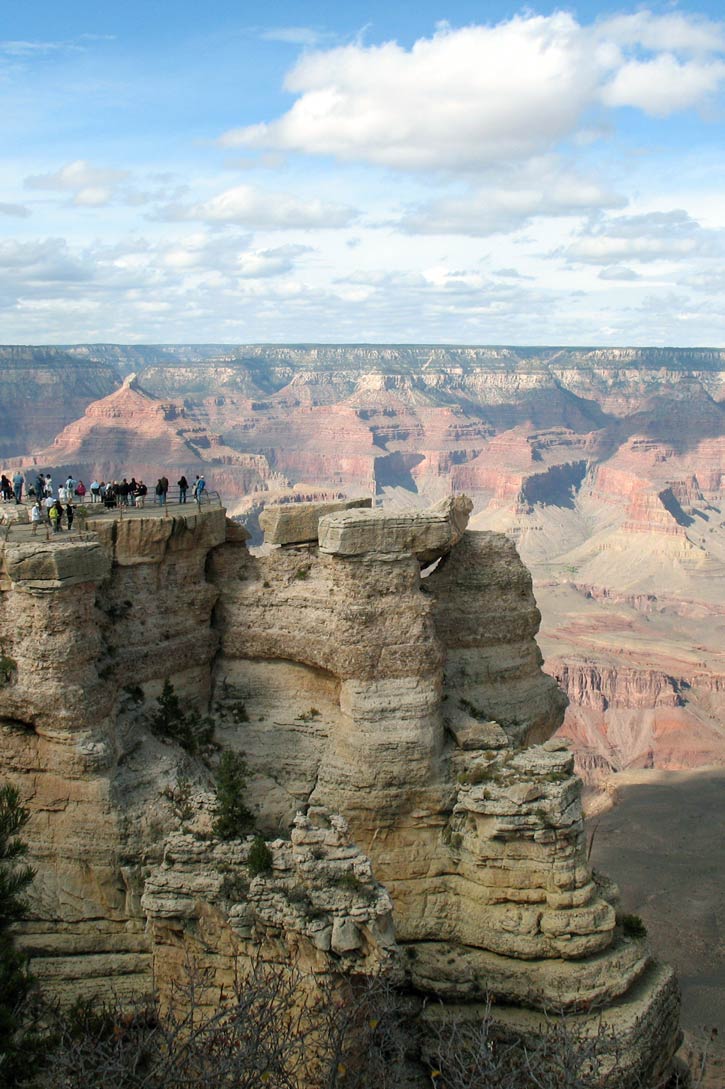
Kids (and adults) are fascinated by Grand Canyon’s geological story, a two-billion-year-old tale that unfolds one rock layer at a time. Photo © Kathleen Bryant.
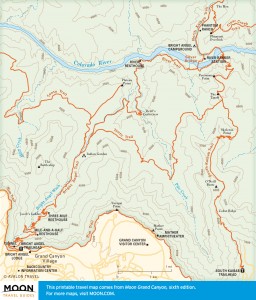
Bright Angel and South Kaibab Trails
The “best” Grand Canyon hike is the one best suited to your family’s schedule and abilities. The Rim Trail (13 miles one way) can be hiked in shorter sections—most are paved and relatively level, good options for hiking with smaller children. Too tame? The steep, dirt-surface South Kaibab Trail that leads to the bottom of the canyon also has kid-friendly day-hike options that offer young explorers a taste of how it feels to enter the canyon’s rocky fortress. Two good turnaround points are Ooh Ah Point (1.8 miles round trip) and Cedar Ridge (3 miles round trip). Begin at Grand Canyon Visitor Center, where you can learn more about trail conditions and catch the free shuttle to the trailhead at Yaki Point. Be sure to bring plenty of water and beat the heat by hiking early.Park rangers can inspire and support your child’s curiosity about the natural world (and help you field all those burning questions about ecosystems and constellations). Kids age 4 and up can earn a Junior Ranger badge by completing a free activity booklet and attending one of several daily ranger programs. Options include hour-long fossil walks near the rim and short ranger talks on the canyon’s critters or rock layers. New for 2015: In April and May, park rangers will lead day camps for kids age 7-14. Activities include guided walks and bus tours highlighting geology, plants, animals, and history.
—Kathleen Bryant, author of Moon Grand Canyon
Rent bikes (or bring your own) and ride the Rim Trail to Hermit’s Rest, stopping at the many overlooks along the way.
Hike a short way down the Bright Angel Trail and say hello to the mule trains passing by, or take a family hike on the half-mile Desert Discovery Trail. On this flat and paved trail, kids will learn all about the rare Saguaro Cactus and its many uses.
—Tim Hull, author of Moon Arizona & the Grand Canyon
Whether your kids are hikers, swimmers, or explorers, you can be sure that America’s National Parks will amaze and inspire them. Take advantage of the Every Kid in a Park initiative, and use these tips to plan your next fun, educational (and hopefully free!) park visit.